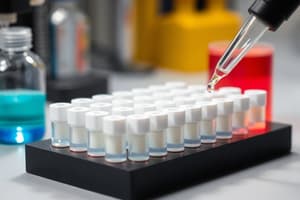Podcast
Questions and Answers
In gas-liquid chromatography, compounds are characterized by their retention times. The Rf value The retention factor, or Rf, is defined as the distance traveled by the compound divided by the distance traveled by the ______.
In gas-liquid chromatography, compounds are characterized by their retention times. The Rf value The retention factor, or Rf, is defined as the distance traveled by the compound divided by the distance traveled by the ______.
solvent
TLC separation mainly depends on : 1. The kind and activity of the adsorbent (stationary phase). 2. The polarity of the eluent (mobile phase). 3. The chemical nature of the components of the ______.
TLC separation mainly depends on : 1. The kind and activity of the adsorbent (stationary phase). 2. The polarity of the eluent (mobile phase). 3. The chemical nature of the components of the ______.
mixture
Silica (SiO2. xH2O) and alumina (Al2O3. xH2O) are the most common adsorbents employed in TLC, and the activity of these adsorbents is highly determined by their ______ content.
Silica (SiO2. xH2O) and alumina (Al2O3. xH2O) are the most common adsorbents employed in TLC, and the activity of these adsorbents is highly determined by their ______ content.
water
For quantitative separations a large glass plates (20x20 cm) are commonly used, while for qualitative purposes they usually use ______ slides.
For quantitative separations a large glass plates (20x20 cm) are commonly used, while for qualitative purposes they usually use ______ slides.
Before the experimental analysis the mixture to be analysed is dissolved in a suitable solvent in a concentration of about 1% solution. Small amount of the diluted solution needed to be withdrawn by a suitable capillary tube in order to spot a small amount of the mixture, usually about 1 cm from the ______.
Before the experimental analysis the mixture to be analysed is dissolved in a suitable solvent in a concentration of about 1% solution. Small amount of the diluted solution needed to be withdrawn by a suitable capillary tube in order to spot a small amount of the mixture, usually about 1 cm from the ______.
Thin layer chromatography is one of the commonly used techniques that may be used to separate or to identify the components of a mixture as well as to examine their ______.
Thin layer chromatography is one of the commonly used techniques that may be used to separate or to identify the components of a mixture as well as to examine their ______.
Chromatography techniques include column, thin-layer, paper gas and ______ chromatography.
Chromatography techniques include column, thin-layer, paper gas and ______ chromatography.
The separation here depends on the selective desorption of the components of a mixture by the eluent (mobile phase) from the surface of a solid adsorbent (stationary phase). The adsorbent may be spread as a thin layer on a glass plate as in thin-layer chromatography or packed in a column as in ______ chromatography.
The separation here depends on the selective desorption of the components of a mixture by the eluent (mobile phase) from the surface of a solid adsorbent (stationary phase). The adsorbent may be spread as a thin layer on a glass plate as in thin-layer chromatography or packed in a column as in ______ chromatography.
The separation depends on partition of the components of a mixture between the stationary and mobile phases. The mobile phase may be gas as in gas-liquid partition chromatography or liquid such as ______ partition chromatography.
The separation depends on partition of the components of a mixture between the stationary and mobile phases. The mobile phase may be gas as in gas-liquid partition chromatography or liquid such as ______ partition chromatography.
Characterization of substances in thin layer and paper chromatography is by their Rf-values (retardation factor). The Rf-value is a number which is characteristic of a compound for a given adsorbent and developing ______.
Characterization of substances in thin layer and paper chromatography is by their Rf-values (retardation factor). The Rf-value is a number which is characteristic of a compound for a given adsorbent and developing ______.
Flashcards are hidden until you start studying
Study Notes
Gas-Liquid Chromatography
- Compounds are characterized by their retention times.
TLC Separation
- Depends on three factors:
- The kind and activity of the adsorbent (stationary phase)
- The polarity of the eluent (mobile phase)
- The chemical nature of the components of the mixture
Adsorbents
- Silica (SiO2.xH2O) and alumina (Al2O3.xH2O) are the most common adsorbents employed in TLC
- Their activity is highly determined by their water content
Plate Selection
- Large glass plates (20x20 cm) are commonly used for quantitative separations
- Small slides are used for qualitative purposes
Sample Preparation
- The mixture to be analyzed is dissolved in a suitable solvent to create a 1% solution
- A small amount of the diluted solution is withdrawn by a suitable capillary tube
- A small amount of the mixture is spotted about 1 cm from the bottom of the plate
Chromatography Techniques
- Techniques include column, thin-layer, paper, gas, and liquid chromatography
- Separation depends on the selective desorption of the components of a mixture by the eluent from the surface of a solid adsorbent
Column Chromatography
- The adsorbent is packed in a column
- Separation depends on partition of the components of a mixture between the stationary and mobile phases
Mobile Phase
- Can be gas (gas-liquid partition chromatography) or liquid (liquid partition chromatography)
Characterization of Substances
- In thin layer and paper chromatography, substances are characterized by their Rf-values (retardation factor)
- Rf-value is a number characteristic of a compound for a given adsorbent and developing solvent
Studying That Suits You
Use AI to generate personalized quizzes and flashcards to suit your learning preferences.



